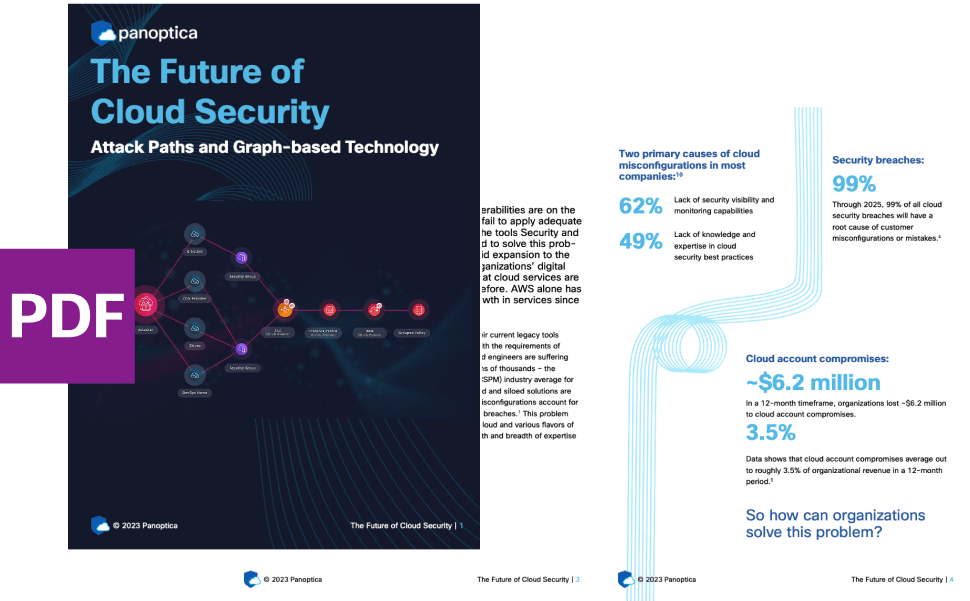INSIGHTS
6 min read

Published on 03/22/2023
Last updated on 04/11/2024
Security observability: What it is and why it matters for cloud security
Share

Security observability: improving threat detection and response
Observability has become a buzzword in the world of software engineering and cloud security in recent years. Simply put, observability is the ability to understand and troubleshoot complex systems by analyzing their behavior.
Security observability and cloud security observability play a crucial role in identifying and addressing security vulnerabilities. In this blog post, we will discuss observability in security and how it can help organizations improve their security posture.
These days, it's more important than ever for organizations to have a comprehensive approach to security monitoring. Traditional security monitoring tools and techniques are no longer sufficient to protect against sophisticated attacks and advanced threats. Your enterprise security only stands to benefit if you can observe more about your systems, like potential threats and vulnerabilities. To maximize this visibility, you’ll need a new approach. You'll need to collect and analyze data from various sources to gain visibility into system behavior and detect security threats.
What is observability in security?
Observability in security refers to the ability to monitor and analyze the behavior of a system or network to detect and respond to security threats. It involves collecting and analyzing data from various sources, such as logs, metrics, network and cloud events and additional data sources to gain visibility into the system's behavior. This approach allows security teams to proactively detect and respond to security incidents before they cause significant harm.
Data sources for security observability
Observability in security involves monitoring several different data sources:
- Network traffic: Monitoring network traffic can help identify suspicious activities such as port scans, brute-force attacks, or data exfiltration attempts.
- Cloud traffic: Cloud traffic monitoring can help detect security threats such as data breaches, unauthorized access, and malicious activity within cloud environments.
- Endpoint data: Endpoint data includes information about the behavior of devices such as laptops, desktops, and mobile phones. This data can be collected using endpoint detection and response (EDR) tools.
- System logs: Examining system logs can help detect unauthorized access attempts, system misconfigurations, or malicious software installations.
- User behavior: Analyzing user behavior can help identify suspicious activities such as repeated failed login attempts, unusual access patterns, or attempts to escalate privileges.
- Application performance: Monitoring application performance can help identify anomalies that could indicate a security issue, such as unexpected spikes in resource usage or changes in application behavior.
- Threat intelligence: Threat intelligence data provides information on known and emerging security threats, including malware, phishing attacks, and other forms of cybercrime.
By collecting and analyzing data from these and other sources, organizations can gain comprehensive observability in security, enabling them to detect and respond to security incidents quickly and effectively.
The benefits of security observability
By adopting an observability-driven approach to security monitoring, organizations can realize several benefits, including:
- Improved threat detection and response: Observability in security allows security teams to detect threats more quickly and accurately, enabling them to respond to incidents before they cause significant harm.
- Better visibility into system behavior: Observability in security provides a more comprehensive view of system behavior, allowing security teams to identify patterns and anomalies that may be indicative of a security issue.
- More proactive approach to security: Observability in security enables security teams to be more proactive in detecting and responding to security incidents, rather than simply reacting to them after the fact.
- Faster incident response: By monitoring and analyzing data in real-time, organizations can respond to security incidents more quickly.
- Enhanced situational awareness: Observability provides organizations with a better understanding of their systems and how they behave, allowing them to make more informed decisions.

Challenges of security observability in the cloud
While observability in security offers many benefits, you’ll also need to know everything that goes into building a stronger cloud security posture. There are several challenges that organizations must address when adopting this approach, including:
- Managing the volume and complexity of data: With so many different sources of data to monitor, organizations must be able to manage and analyze large volumes of data, while ensuring that they are focusing on the most relevant data sources and metrics.
- Ensuring data privacy and compliance: Collecting and analyzing data from various sources raises privacy and compliance concerns, as organizations must ensure that they are collecting and using data in a way that complies with applicable regulations and industry standards.
- Integrating with existing security tools and processes: Adopting observability in security sometimes requires integrating with existing security tools and processes, which can be a complex and time-consuming process.
Best practices for observability in security
To ensure that they are getting the most out of observability in security, companies should follow these best practices and more:
- Focus on relevant data and metrics: With so much data to monitor, focus on the most relevant data sources and the metrics that are most likely to indicate a security issue. This can help reduce noise and false positives, enabling security teams to focus on the most critical threats.
- Automate analysis and response: Automation can help streamline the process of detecting and responding to security incidents. By automating the analysis of security data, organizations can more quickly identify threats and respond to them in a timely manner, reducing the risk of data loss or other negative consequences.
- Adopt a risk-based approach: Organizations should adopt a risk-based approach to security monitoring, focusing on the most critical assets and systems. This can help assign resources more effectively so that the most important security threats are being addressed.
- Ensure data privacy and compliance: Collecting and analyzing data from various sources raises privacy and compliance concerns. Organizations must ensure that they are collecting and using data in a way that is compliant with applicable regulations and industry standards and that data privacy is protected.
- Monitor cloud traffic: With the increasing adoption of cloud services and infrastructure, organizations need to monitor traffic between cloud services, applications, and systems. Cloud traffic monitoring can help detect security threats like data breaches, unauthorized access, and malicious activity within cloud environments.

Improving visibility into your organization's cloud, data, and systems
Observability in security is a critical component of modern cybersecurity. It involves collecting and analyzing data from various sources to gain better visibility into security threats and incidents.
Observability in security requires collaboration between security teams and other stakeholders, a focus on relevant data and metrics, automation of analysis and response, adoption of a risk-based approach, and ensuring data privacy and compliance.
By following these best practices for observability in security, organizations can improve their ability to detect and respond to security incidents and better protect their systems and data.
Want to learn more? We’ve also written about full-stack observability and how you can better tackle cloud visibility and other challenges in the modern enterprise environment.


Get emerging insights on emerging technology straight to your inbox.
Unlocking Multi-Cloud Security: Panoptica's Graph-Based Approach
Discover why security teams rely on Panoptica's graph-based technology to navigate and prioritize risks across multi-cloud landscapes, enhancing accuracy and resilience in safeguarding diverse ecosystems.

Related articles

The Shift keeps you at the forefront of cloud native modern applications, application security, generative AI, quantum computing, and other groundbreaking innovations that are shaping the future of technology.





